“Thirty Hours to Live” by Franklin M. Ritchie
THIS week we have 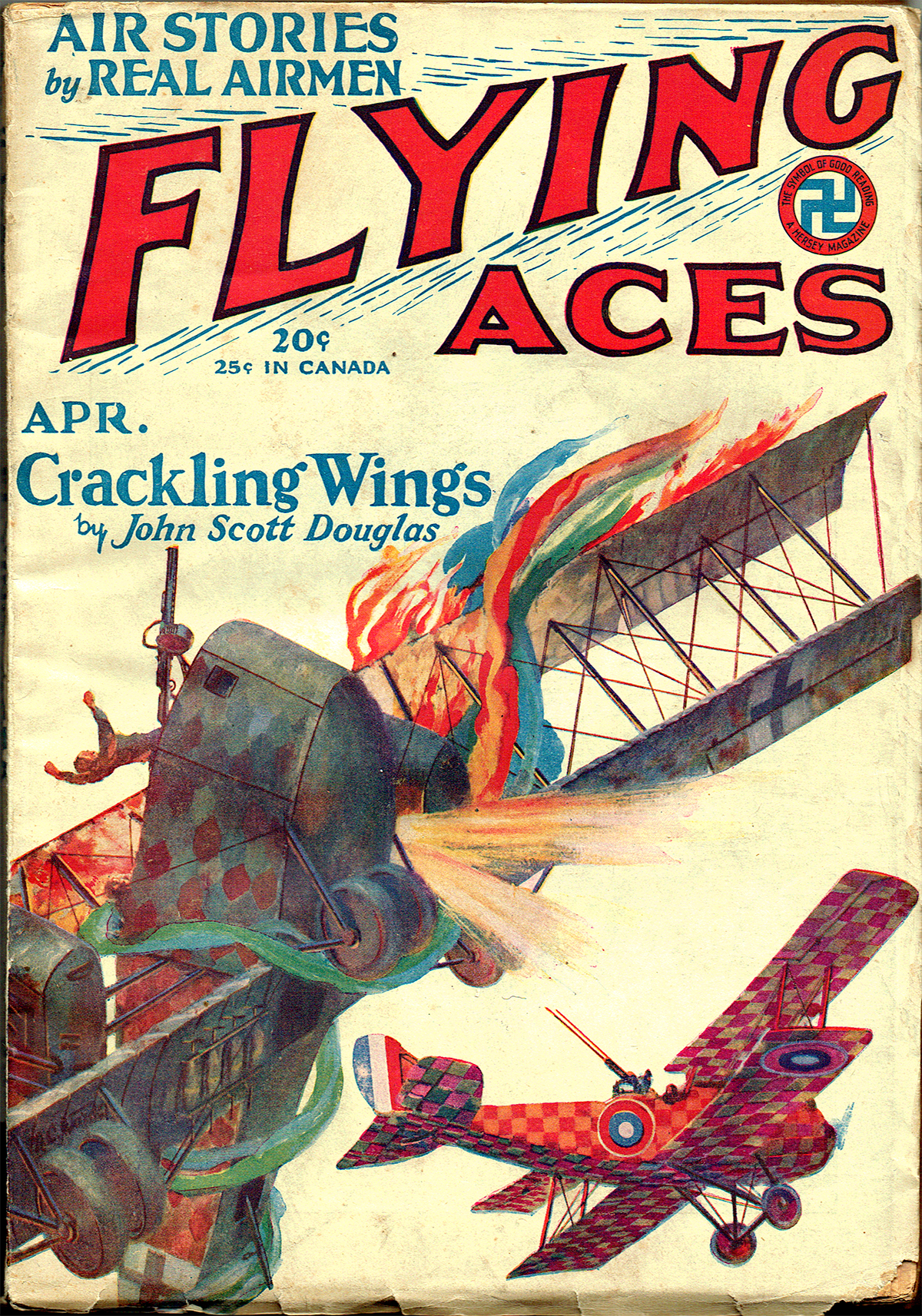 a story by Franklin M. Ritchie. Ritchie only wrote aviation yarns and his entire output—roughly three dozen stories—was between 1927 and 1930, but Ritchie was not your typical pulp author—he was a lawyer who wrote pulp stories on the side to satisfy his yen for flying.
a story by Franklin M. Ritchie. Ritchie only wrote aviation yarns and his entire output—roughly three dozen stories—was between 1927 and 1930, but Ritchie was not your typical pulp author—he was a lawyer who wrote pulp stories on the side to satisfy his yen for flying.
Jack Gorham flew in a trance. “Thirty hours to live!” he muttered, talking to himself under the roar of the motor and the fierce screaming of the wind in his wires. “That’s all a pilot has on the front!” And mechanically he fell into the formation. Swiftly they winged toward the front. The trenches zigzagged under them, and suddenly Gorham realized that he was over German territory, “Thirty hours to live!” he repeated to himself. . .
With a weird shrieking whir, the airplane streaked for earth like a flaming comet. The pilot’s chum turned yellow and fled, but—read it and see for yourself!
As a bonus, here’s a letter from Franklin M. Ritchie that Flying Aces published in the March issue—the month before the issue this story ran.

“In The Clouds” by Franklin M. Ritchie
THIS week we have 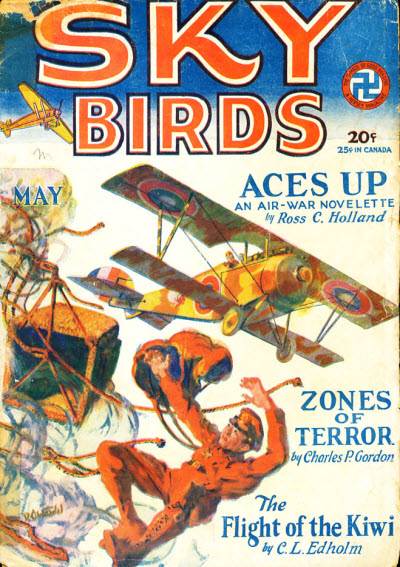 another story by Franklin M. Ritchie. Ritchie only wrote aviation yarns and his entire output—roughly three dozen stories—was between 1927 and 1930. Today we have another one from the lawyer who wrote pulp stories on the side to satisfy his yen for flying. From the May 1929 issue of Sky Birds, Ritchie gives us a tale of Lieutenant Hank Durant.
another story by Franklin M. Ritchie. Ritchie only wrote aviation yarns and his entire output—roughly three dozen stories—was between 1927 and 1930. Today we have another one from the lawyer who wrote pulp stories on the side to satisfy his yen for flying. From the May 1929 issue of Sky Birds, Ritchie gives us a tale of Lieutenant Hank Durant.
Hank Durant, flying instructor of Issoudun, A.W.O.L., was up in an unarmed observation training ship—the American battery was firing short of the Big Bertha—his radio dynamo was shot—but getting the Big Bertha meant more to him than just fighting!—There was Betty Kramer’s admiration for one thing and there was Phil Marcel to settle with for another!
“Say It With Bombs” by Franklin M. Ritchie
THIS week we have 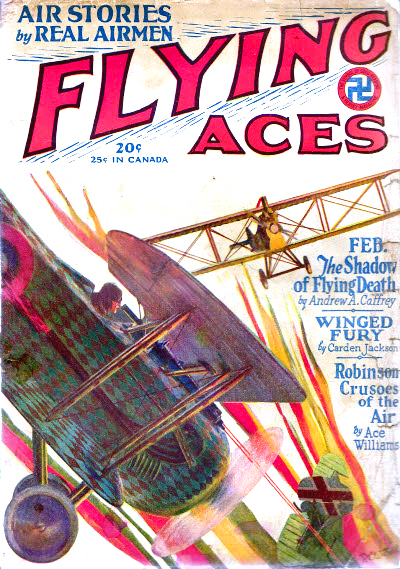 another story by Franklin M. Ritchie. Ritchie only wrote aviation yarns and his entire output—roughly three dozen stories—was between 1927 and 1930. Today we have another one from the lawyer who wrote pulp stories on the side to satisfy his yen for flying. From an early issue of Flying Aces, Ritchie gives us a tale of bomber Jim Barker who longed to show everyone that even a bombing pilot can get Germany’s most ruthless Ace, by any means necessary! From the February 1929 issue of Flying Aces, it’s Franklin M. Ritchie’s “Say It With Bombs!”
another story by Franklin M. Ritchie. Ritchie only wrote aviation yarns and his entire output—roughly three dozen stories—was between 1927 and 1930. Today we have another one from the lawyer who wrote pulp stories on the side to satisfy his yen for flying. From an early issue of Flying Aces, Ritchie gives us a tale of bomber Jim Barker who longed to show everyone that even a bombing pilot can get Germany’s most ruthless Ace, by any means necessary! From the February 1929 issue of Flying Aces, it’s Franklin M. Ritchie’s “Say It With Bombs!”
When the swarm of German Fokkers swept out of the clouds and met an American bombing party they struck a lot of red-hot action they hadn’t counted on. Jim Barker believed in using whatever tools are at hand—and, “They Learned about bombs from him.”
“Flaming Bullets” by Franklin M. Ritchie
THIS week we have 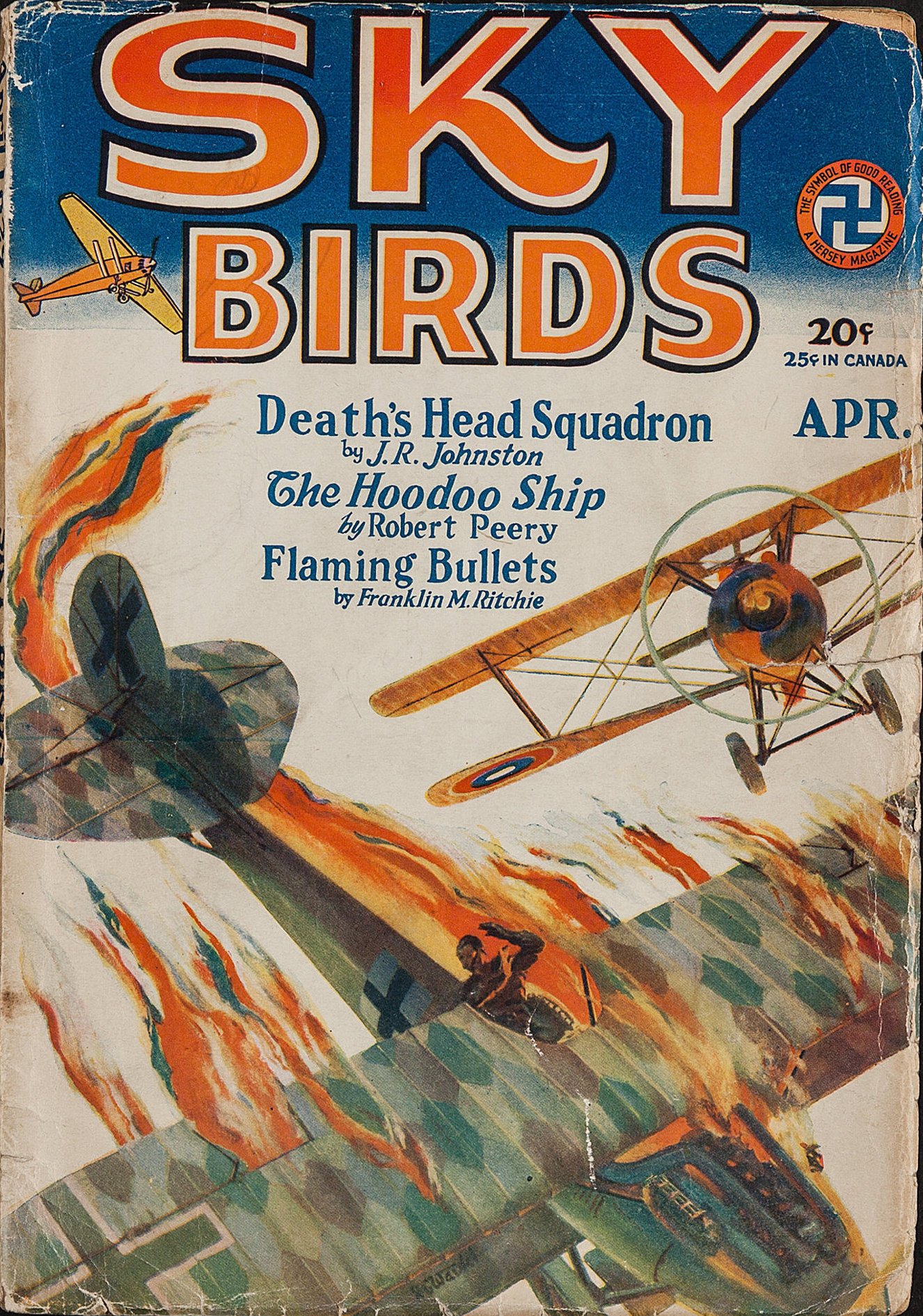 another story by Franklin M. Ritchie. Ritchie only wrote aviation yarns and his entire output—roughly three dozen stories—was between 1927 and 1930. Today we have another one from the lawyer who wrote pulp stories on the side to satisfy his yen for flying. From an early issue of Sky Birds, Ritchie gives us a tale of the chivalry of the air—but from the German point of view. Enter young Oberleutnant Fritz von Hullesheim who gets himself into a real mess over his flight leaders use of incendiary bullets in his air battles.
another story by Franklin M. Ritchie. Ritchie only wrote aviation yarns and his entire output—roughly three dozen stories—was between 1927 and 1930. Today we have another one from the lawyer who wrote pulp stories on the side to satisfy his yen for flying. From an early issue of Sky Birds, Ritchie gives us a tale of the chivalry of the air—but from the German point of view. Enter young Oberleutnant Fritz von Hullesheim who gets himself into a real mess over his flight leaders use of incendiary bullets in his air battles.
From the April 1929 issue of Sky Birds, it’s Franklin M. Ritchie’s “Flaming Bullets!”
The amazing chivalry of the men of the air astounded the whole world during the war. They were true sportsmen, those sky-fighters. Here is a breath-taking yarn from behind the enemy lines showing how the picture looked through the eyes of German War Flyers!
“Flying Ghosts” by Franklin M. Ritchie
THIS week we have 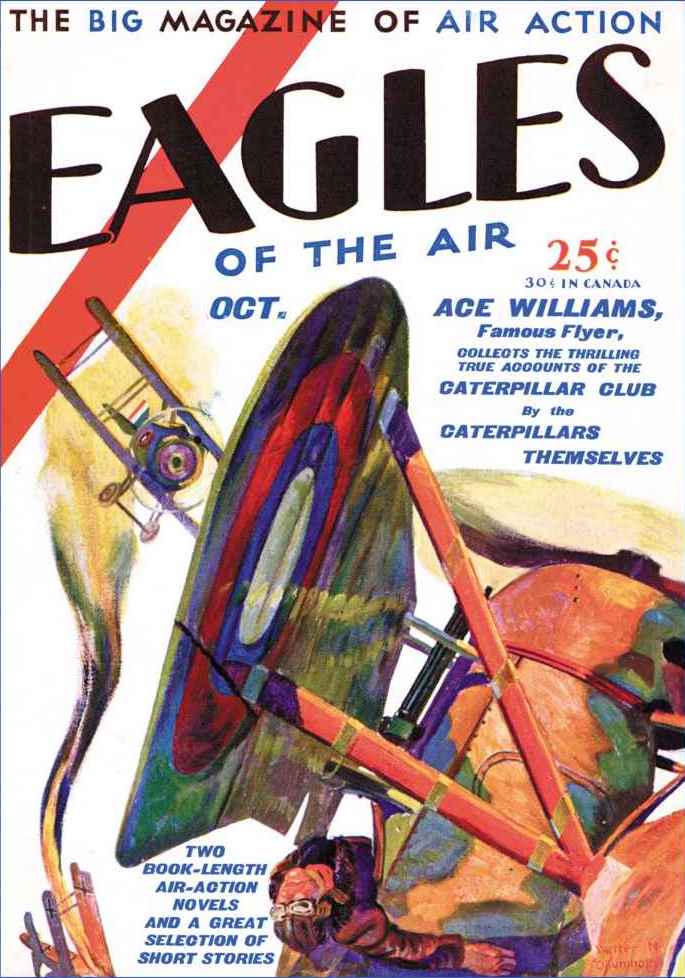 another story by Franklin M. Ritchie. Ritchie only wrote aviation yarns and his entire output—roughly three dozen stories—was between 1927 and 1930. Today we have another one from the lawyer who wrote pulp stories on the side to satisfy his yen for flying. From the premier issue of the short lived Eagle of the Air, Ritchie tells the story of rookie pilot Eric Folsom and his rise to responsible squadron veteran.
another story by Franklin M. Ritchie. Ritchie only wrote aviation yarns and his entire output—roughly three dozen stories—was between 1927 and 1930. Today we have another one from the lawyer who wrote pulp stories on the side to satisfy his yen for flying. From the premier issue of the short lived Eagle of the Air, Ritchie tells the story of rookie pilot Eric Folsom and his rise to responsible squadron veteran.
From the October 1929 issue of Eagles of the Air, it’s Franklin M. Ritchie’s “Flying Ghosts!”
Battle on battle surged in the clouds—men leaped to death through tracer-scorched skies—but when the squadron leaders went down, Eric Folsom just had to find his wings!
“Crumpled Buzzard” by Franklin M. Ritchie
THIS week we have 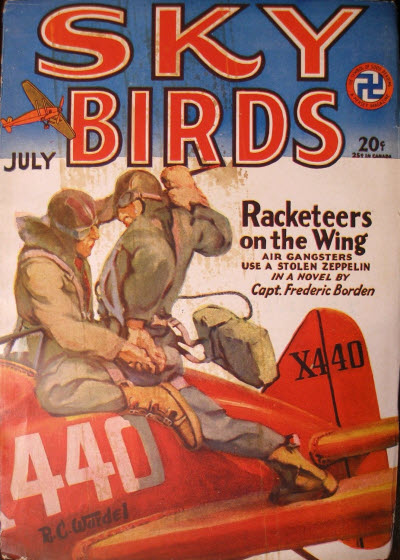 a story by Franklin M. Ritchie. Ritchie only wrote aviation yarns and his entire output—roughly three dozen stories—was between 1927 and 1930, but Ritchie was not your typical pulp author.
a story by Franklin M. Ritchie. Ritchie only wrote aviation yarns and his entire output—roughly three dozen stories—was between 1927 and 1930, but Ritchie was not your typical pulp author.
After reading “Crumpled Buzzards” I tried to find out a little about Ritchie to include in this post. I thought he had been covered in a biographical piece in Air Trails or Sky Birds, but couldn’t find anything. So I turned to the internet.
In putting in the name some great stuff comes up—letters from when he was a cadet to teachers back at Rutgers; a long letter to the folks back at Central New Jersey Home News where he was reporter before the war; he married fellow Erasmus High grad Elizabeth Farrish before enlisting; and this brief biographical piece from the Perth Amboy Evening News (September 23, 1922)—

All this good stuff was tied to this Lawyer fellow from New Brunswick. He seems to have an incredibly full life, when would he have time write pulp stories? But then I found a letter from Ritchie buried in the April 1929 issue of Sky Birds that explains it all:

Ritchie retired from all that in ‘58, moved out west and become a pastor at a Presbyterian church in Lakewood, California. He passed away at 84 in 1978.
With all that in mind, from the July 1929 number of Sky Birds, it’s Franklin M. Ritchie’s “Crumpled Buzzards!”
Lanky Jeff Dayton, a war bird, saw nothin’ to get het up about in this man’s war, but when he did, he saw red—red streaks of flame jetting from angry guns.
 a story by Franklin M. Ritchie. Ritchie only wrote aviation yarns and his entire output—roughly three dozen stories—was between 1927 and 1930, but Ritchie was not your typical pulp author—he was a lawyer who wrote pulp stories on the side to satisfy his yen for flying.
a story by Franklin M. Ritchie. Ritchie only wrote aviation yarns and his entire output—roughly three dozen stories—was between 1927 and 1930, but Ritchie was not your typical pulp author—he was a lawyer who wrote pulp stories on the side to satisfy his yen for flying.





 another story by Franklin M. Ritchie. Ritchie only wrote aviation yarns and his entire output—roughly three dozen stories—was between 1927 and 1930. Today we have another one from the lawyer who wrote pulp stories on the side to satisfy his yen for flying. From the May 1929 issue of Sky Birds, Ritchie gives us a tale of Lieutenant Hank Durant.
another story by Franklin M. Ritchie. Ritchie only wrote aviation yarns and his entire output—roughly three dozen stories—was between 1927 and 1930. Today we have another one from the lawyer who wrote pulp stories on the side to satisfy his yen for flying. From the May 1929 issue of Sky Birds, Ritchie gives us a tale of Lieutenant Hank Durant. another story by Franklin M. Ritchie. Ritchie only wrote aviation yarns and his entire output—roughly three dozen stories—was between 1927 and 1930. Today we have another one from the lawyer who wrote pulp stories on the side to satisfy his yen for flying. From an early issue of Flying Aces, Ritchie gives us a tale of bomber Jim Barker who longed to show everyone that even a bombing pilot can get Germany’s most ruthless Ace, by any means necessary! From the February 1929 issue of Flying Aces, it’s Franklin M. Ritchie’s “Say It With Bombs!”
another story by Franklin M. Ritchie. Ritchie only wrote aviation yarns and his entire output—roughly three dozen stories—was between 1927 and 1930. Today we have another one from the lawyer who wrote pulp stories on the side to satisfy his yen for flying. From an early issue of Flying Aces, Ritchie gives us a tale of bomber Jim Barker who longed to show everyone that even a bombing pilot can get Germany’s most ruthless Ace, by any means necessary! From the February 1929 issue of Flying Aces, it’s Franklin M. Ritchie’s “Say It With Bombs!” another story by Franklin M. Ritchie. Ritchie only wrote aviation yarns and his entire output—roughly three dozen stories—was between 1927 and 1930. Today we have another one from the lawyer who wrote pulp stories on the side to satisfy his yen for flying. From an early issue of Sky Birds, Ritchie gives us a tale of the chivalry of the air—but from the German point of view. Enter young Oberleutnant Fritz von Hullesheim who gets himself into a real mess over his flight leaders use of incendiary bullets in his air battles.
another story by Franklin M. Ritchie. Ritchie only wrote aviation yarns and his entire output—roughly three dozen stories—was between 1927 and 1930. Today we have another one from the lawyer who wrote pulp stories on the side to satisfy his yen for flying. From an early issue of Sky Birds, Ritchie gives us a tale of the chivalry of the air—but from the German point of view. Enter young Oberleutnant Fritz von Hullesheim who gets himself into a real mess over his flight leaders use of incendiary bullets in his air battles. another story by Franklin M. Ritchie. Ritchie only wrote aviation yarns and his entire output—roughly three dozen stories—was between 1927 and 1930. Today we have another one from the lawyer who wrote pulp stories on the side to satisfy his yen for flying. From the premier issue of the short lived Eagle of the Air, Ritchie tells the story of rookie pilot Eric Folsom and his rise to responsible squadron veteran.
another story by Franklin M. Ritchie. Ritchie only wrote aviation yarns and his entire output—roughly three dozen stories—was between 1927 and 1930. Today we have another one from the lawyer who wrote pulp stories on the side to satisfy his yen for flying. From the premier issue of the short lived Eagle of the Air, Ritchie tells the story of rookie pilot Eric Folsom and his rise to responsible squadron veteran.  a story by Franklin M. Ritchie. Ritchie only wrote aviation yarns and his entire output—roughly three dozen stories—was between 1927 and 1930, but Ritchie was not your typical pulp author.
a story by Franklin M. Ritchie. Ritchie only wrote aviation yarns and his entire output—roughly three dozen stories—was between 1927 and 1930, but Ritchie was not your typical pulp author. 
